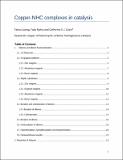Copper-NHC complexes in catalysis
Abstract
Although the chemistry of copper has a long history [1a-d], the relatively recent discovery of N-heterocyclic carbene (NHC) as transition-metal supporting ligands has permitted novel vistas to be explored in copper reactivity and catalysis [1e,f]. Shortly after the seminal discovery of Arduengo, Raubenheimer reported a neutral copper carbene complex [1] and [2]. However, the field remained dormant for almost ten years. In the early 2000s, new breakthroughs were achieved: first, the synthesis of NHC–copper using Cu2O was reported by Danopoulos and followed by the first application in catalysis by Woodward [3] and [4]. The work by Buchwald and Sadighi appeared next, where the first catalysis using a well-defined complex was described [5]. The first reports in this field were based on systems used to mimic their phosphine relatives. NHCs have become ligands of significant interest due to their steric and electronic properties [6], [7] and [8]. Combining the NHC ligand family and copper became, for some, an obvious and productive area [6]. Over the last decade alone, numerous systems have been developed. Copper–NHC complexes can be divided into two major classes: neutral mono-NHC and cationic bis-NHC derivatives: [Cu(X)(NHC)] [9] (X = halide, acetate, hydroxide, hydride, etc.) and [Cu(NHC)(L)][Y] (L = NHC or PR3; Y = PF6, BF4) [10]. The neutral-halide-bearing complexes have been widely used in catalysis, mainly due to their ease of synthesis [9]. In addition to halide-bearing complexes, notable important related compounds have been reported: Nolan and co-workers disclosed the first hydroxide derivative [Cu(OH)(IPr)] (IPr = N,N’-bis(2,6-di-isopropylphenyl)imidazol-2-ylidene) and Sadighi published alkoxides, hydrides and borate species, which permitted novel reactivity to be explored [9g-i]. With respect to cationic derivatives, homoleptic and heteroleptic bis-NHC complexes have been reported and have been efficiently used in catalysis allowing important improvements [10]. In this review, an overview of the two classes and their respective catalytic performance will be presented.
Citation
Lazreg , F , Nahra , F & Cazin , C S J 2015 , ' Copper-NHC complexes in catalysis ' , Coordination Chemistry Reviews , vol. 293-294 , pp. 48-79 . https://doi.org/10.1016/j.ccr.2014.12.019
Publication
Coordination Chemistry Reviews
Status
Peer reviewed
ISSN
0010-8545Type
Journal article
Description
The authors gratefully acknowledge the Royal Society (University Research Fellowship to C.S.J.C.) for funding.Collections
Items in the St Andrews Research Repository are protected by copyright, with all rights reserved, unless otherwise indicated.

